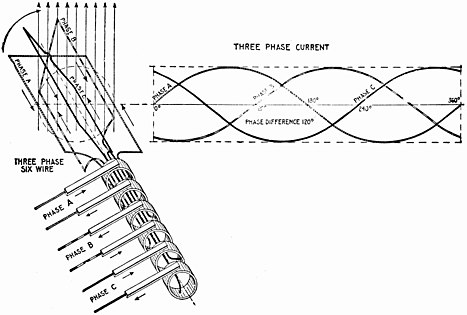Mathematics of three-phase electric power
In electrical engineering, three-phase electric power systems have at least three conductors carrying alternating voltages that are offset in time by one-third of the period. A three-phase system may be arranged in delta (∆) or star (Y) (also denoted as wye in some areas, as symbolically it is similar to the letter 'Y'). A wye system allows the use of two different voltages from all three phases, such as a 230/400 V system which provides 230 V between the neutral (centre hub) and any one of the phases, and 400 V across any two phases. A delta system arrangement provides only one voltage, but it has a greater redundancy as it may continue to operate normally with one of the three supply windings offline, albeit at 57.7% of total capacity.[1] Harmonic current in the neutral may become very large if nonlinear loads are connected.
The below images demonstrate how a system of six wires delivering three phases from an alternator may be replaced by just three. A three-phase transformer is also shown.
Revolving magnetic field[edit]
Any polyphase system, by virtue of the time displacement of the currents in the phases, makes it possible to easily generate a magnetic field that revolves at the line frequency. Such a revolving magnetic field makes polyphase induction motors possible. Indeed, where induction motors must run on single-phase power (such as is usually distributed in homes), the motor must contain some mechanism to produce a revolving field, otherwise the motor cannot generate any stand-still torque and will not start. The field produced by a single-phase winding can provide energy to a motor already rotating, but without auxiliary mechanisms the motor will not accelerate from a stop.
A rotating magnetic field of steady amplitude requires that all three phase currents be equal in magnitude, and accurately displaced one-third of a cycle in phase. Unbalanced operation results in undesirable effects on motors and generators.
Conversion to other phase systems[edit]
Provided two voltage waveforms have at least some relative displacement on the time axis, other than a multiple of a half-cycle, any other polyphase set of voltages can be obtained by an array of passive transformers. Such arrays will evenly balance the polyphase load between the phases of the source system. For example, balanced two-phase power can be obtained from a three-phase network by using two specially constructed transformers, with taps at 50% and 86.6% of the primary voltage. This Scott T connection produces a true two-phase system with 90° time difference between the phases. Another example is the generation of higher-phase-order systems for large rectifier systems, to produce a smoother DC output and to reduce the harmonic currents in the supply.
When three-phase is needed but only single-phase is readily available from the electricity supplier, a phase converter can be used to generate three-phase power from the single phase supply. A motor–generator is often used in factory industrial applications.
System measurements[edit]
In a three-phase system, at least two transducers are required to measure power when there is no neutral, or three transducers when there is a neutral.[5] Blondel's theorem states that the number of measurement elements required is one less than the number of current-carrying conductors.[6]


